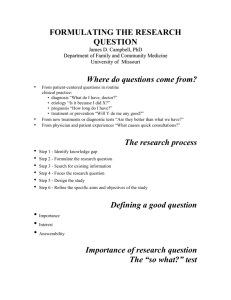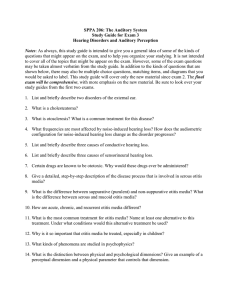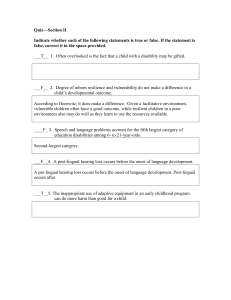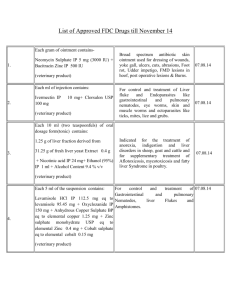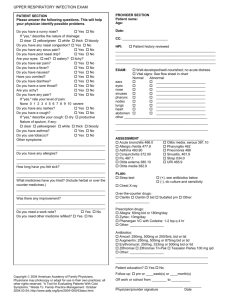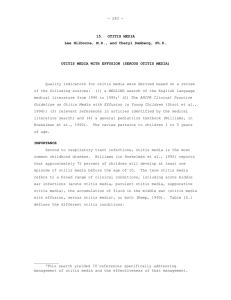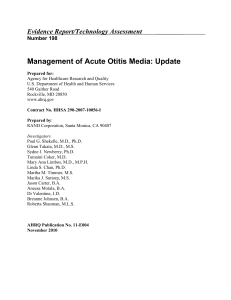FORMULATING THE RESEARCH QUESTION James D. Campbell, PhD
advertisement
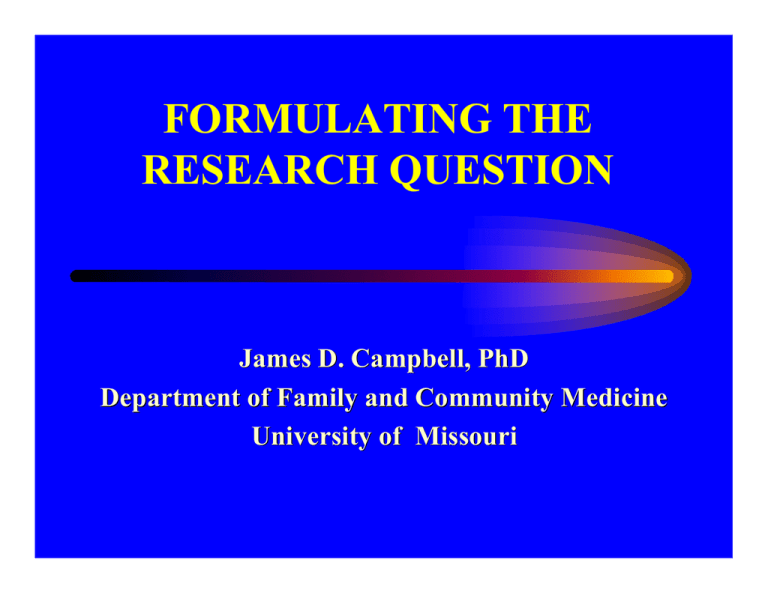
FORMULATING THE RESEARCH QUESTION James D. Campbell, PhD Department of Family and Community Medicine University of Missouri Where do questions come from? • • • From patient-centered questions in routine clinical practice: • diagnosis “What do I have, doctor?” • etiology “Is it because I did X?” • prognosis “How long do I have?” • treatment or prevention “Will Y do me any good?” From new treatments or diagnostic tests “Are they better than what we have?” From physician and patient experiences “What causes quick consultations?” The research process • • • • • • Step 1 - Identify knowledge gap Step 2 - Formulate the research question Step 3 - Search for existing information Step 4 - Focus the research question Step 5 - Design the study Step 6 - Refine the specific aims and objectives of the study Defining a good question • Importance • Interest • Answerability Importance of research question The “so what?” test Disease or condition Intervention Major effects on Major effects on the patient or society caregiver Frequency of use Financial cost or potential for use Uncertainty of Degree of Ability to change practice benefit or variation established Feasibility of assessment in practice preferences Availability of data Financial cost Interest of research question • • • • • • Motivation Innovation Topicality Ethical considerations Political considerations Social considerations Answerability of research question • Type III error: Asking the wrong question “Far better an approximate answer to the right question, which is often vague, than an exact answer to the wrong question, which can always be made precise.” - John Tukey • Type IV error: Asking a question not worth answering Types of questions Variance questions • Focuses on difference and correlation • “Is (are) there” “Does” How much” “To what extent” • Quantitative/Clinical • Starting point or primary determinant of the design Process questions • Focuses on “how” and “why” things happen • Qualitative Components of the clinical question Population - type of person Intervention (exposure) - type of exposure Comparisons - type of control Outcomes - type of outcome Refining the clinical question Type of exposure ↓ Are anticoagulant agents useful in patients who have had a stroke? ↑ Type of patient The well-formulated question Type of exposure ↓ Type of outcomes ↓ Do anticoagulant agents improve outcomes in Type of person ↓ patients with acute ischemic stroke Type of control ↓ compared with no treatment? Operationalizing the research question • Each component (variable) of the research question needs to be defined in terms of the operations required to measure them. • These need to be specified in the Specific Aims section of a grant. PICO - Population Example: Is amoxicillin effective for otitis media? • Is “otitis media” • • • • otitis media according to physician diagnosis? otitis media based on tympanometry readings? fever and ear pain? Do you consider infants and adults? PICO - Intervention Is amoxicillin effective for otitis media? • • Are antibiotics effective for otitis media? • Are any treatments effective for otitis media? Myringotomy? Humidifier? Are any drugs effective for otitis media? Decongestants? PICO - Comparisons Example: Is amoxicillin effective for otitis media? • Does this translate to: • Efficacy - vs. control or placebo • Comparative efficacy - vs. standard therapy PICO - Outcome Example: Is amoxicillin effective for otitis media? • Does amoxicillin prevent long-term hearing loss? • • • Requires trials with long-term follow-up Requires trials which assess hearing Does amoxicillin reduce pain? • Requires trials which assess pain The FINER criteria for a good research question • Feasible • Adequate number of subjects • Adequate technical expertise • Affordable in time and money • Manageable in scope • Interesting • Interesting to the investigator The FINER criteria for a good research question • Novel • Confirms or refutes previous findings • Extends previous findings • Provides new findings • • Ethical Relevant • To scientific knowledge • To clinical and health policy • To future research directions Visualizing the research question • Visual refining of a research question can help in making a verbal commitment to it. • Having a conceptual or theoretical framework also helps toward refining the research question. Conceptualization theory construction The Concept The generation of the concept is at the heart of a theory, what Whewell called the idea of theory…a matter of analogy. Building a theory is a matter of developing an appropriate concept by analogy. This is the essential heart of science because it is the basis of explanation. The distinctions required by science in order to explain phenomena, can best be made by introducing a new concept, which allows the scientist to analyze analogical relationships a good deal more carefully and finely… a theory is often nothing but the description and exploitation of some model. Theoretical models with their metaphorically constituted theory terms provide us with a metaphorically and tentative idea between the unknown and the observed properties. Such a postulated structure or model functions as an hypothesis concerning explanation. Botha, 1989 Concept analysis Principles • Concepts should be clearly defined and well differentiated from other concepts (epistemological principle) • Concepts should be coherently and systematically related to other concepts ( logical principle) • Concepts should be applicable to the world or operationalized (the pragmatic principle) • Concepts should be appropriate to their use in context (linguistic principle) Morse, et al., 1996 Relations of concepts Conceptualization requires identification of relations between concepts. In the context of rationale, expressions of relations are referred to as propositions. When the propositions rest upon assumptions, they need to be explicit in the rationale, providing the reader with full explication of the investigator’s meanings and reasoning. Critiques of the rationale can occur from (1) the degree of completeness of the components and relationships and from (2) the validity in relation to available evidence. Conceptualization types of research • Descriptive Research - Identify and fully describe the defining characteristics and particulars of concepts of interest • Exploratory Research - Discover what other phenomena cause or coexist with the concept • Explanatory Research - Shift from asking what factors are related to the concept to why they are related Interactive patient model BIOLOGY Genetics Bio System Response BEHAVIOR Coping Illness COGNITIVE Appraisal Meaning “Explanatory Models” ENVIRONMENT Life Events Reinforcers SOCIOCULTURAL Social Support Custom, Values Sanctions Benefits of a well-formatted research question • Aids in reducing the work for a literature review • • Aids in the development of hypotheses • Aids in clarifying relationships among variables Aids in the development of a conceptual or theoretical framework The qualitative research question • The research question is the result of an interactive design process rather than the starting point • Initial questions are designed to focus and develop more specific questions during the research process Refining the qualitative research question • What you want to understand by doing the study vs. what you want to accomplish • Example: “What is the best way to increase medical students’ knowledge of science?” vs. “How do exemplary teachers help medical students learn science?” • In interview studies your research questions identify the things you want to understand; your interview questions generate the data that you need to understand these things. Approaches to the qualitative research question • Instrumentalist questions focus on what can be observed: “How are exemplary teachers observed to teach basic science?” • Realist questions incorporate beliefs, feelings, and intentions as fallible evidence to be used critically to test ideas about what is going on: “How do exemplary teachers help medical students learn science?” Kinds of qualitative questions • Questions about the meaning of events and activities to the people involved in them • Questions about the influence of the physical and social context on these events and activities Example of small grant concept paper Comments from the Chief of NIMH Health and Behavioral Science Research Branch: • • • • A detailed, empirically-supported conceptual/theoretical framework that guides specific aims, selection of measures, analysis, etc. is a critical foundation for any application. In addition to somatization disorder, would you be measuring depression and anxiety disorders/symptoms/related disability as part of the “stress-related symptoms? Are there particular medical outcomes of interest based on prevalence estimates in this population from the existing literature? A more focused range of mental and medical outcomes would probably enhance the statistical power of your proposed study Explicit relevance to mental disorders/symptoms/related disability should be reflected in the title, abstract, theoretical framework, specific aims, measures and analyses. Example of small grant concept paper Comments from CPCR staff review: • • • The section on significance and description of this “special population” was informative but need to describe types of incarceration a bit more e.g., difference between a jail, prison, detention in terms of how the individual moves through the system. Although the research questions are stated on page 4 and outlined in the Aims, some reviewers felt a defined hypothesis would help focus the study on outcomes. Always ask the question--so what? What difference will this research make in the health of the American public? Some thoughts--perhaps an outcome is a set of screening question(s) useful to primary care practitioners’ assessment of the patient. Or, if you decide to research and explore the impact on children as noted on page 3 of the concept paper, an outcome could be expansion of funding for support groups as part of the improved care recommendations. Revised specific aims • To estimate the percentage of adult female primary care patients with an incarcerated family member, and determine if practicespecific rates vary by practice characteristics such as proportion of minority populations served and proportion of underinsured patients • To describe and compare adult female patients with and without the family incarceration experience with regard to biopsychosocial characteristics (sociodemographics, medical problems, physical/psychological symptoms, perceived stress, stressful life events, substance use, coping, social support, family functioning, presenting complaints, mental health symptoms, quality of life, and service utilization), and • To investigate the relationship between family member incarceration and health outcomes (health related quality of life and its components) and service utilization.
